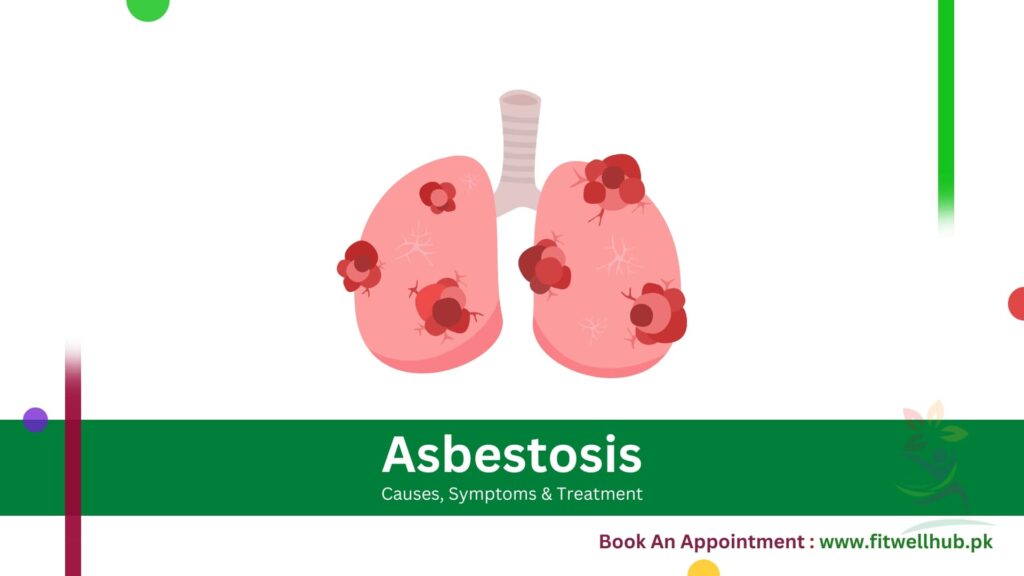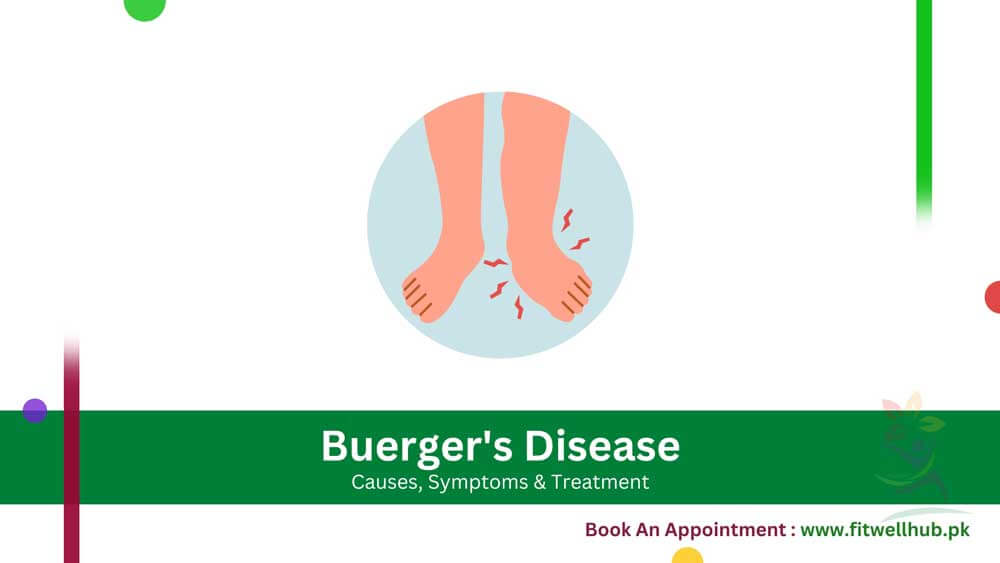Asbestosis is a chronic lung disease caused by the inhalation of asbestos fibers. The continuous irritation of the substance on the lung tissue results in scarring and swelling over time; this causes the shrinking of the lungs, eventually hampering their normal expansion and contraction. People who work in construction, manufacturing, or shipbuilding commonly develop due to asbestos exposure. Because it takes a lot of time for symptoms to appear, asbestos causes irreversible damage, and serious complications, such as lung cancer and heart failure, may occur.
Quick Links
ToggleAsbestosis affects a significant number of individuals in Pakistan, particularly in high-risk areas like Khyber Pakhtunkhwa and Gadani. While exact prevalence data is lacking, airborne asbestos levels in some regions exceed safety limits by over 100 times, posing severe health risks to workers in the mining and shipbreaking industries.
Symptoms
Symptoms commonly associated with asbestosis include the following:
- Inhalation of Asbestos Fibers: Microscopic asbestos fibers enter the body through respiration, causing asbestosis. These fibers lodge in the lungs, leading to irritation and long-term scarring.
- Long-term Exposure to Asbestos: Prolonged exposure, especially in work environments, increases the risk of asbestosis as lung damage accumulates over time.
- Occupational Hazards: Workers in industries like manufacturing, construction, mining, and shipbuilding are at higher risk of asbestos exposure, especially if safety regulations are not followed.
- Environmental Exposure: Damaged or deteriorated asbestos-containing materials in buildings can release fibers, leading to potential indoor asbestos exposure.
- Poor Protective Measures: Inadequate protective equipment or failure to adhere to safety protocols increases the risk of asbestos exposure and the development of asbestosis.
When to See a Doctor
You need to see a doctor if you have a medical history of asbestos exposure and symptoms like shortness of breath, a persistent cough, or chest discomfort. This is necessary because early detection and monitoring enable the effective management of the condition to prevent complications such as lung cancer. People working in industries that expose them to asbestos should undergo regular check-ups for the detection of early signs of lung damage.
At FitwellHub, we offer comprehensive respiratory evaluations and lung health screenings to detect asbestosis early. Book an appointment with us today, and let our experts guide you on your wellness journey!
Causes
The various causes of asbestosis are:
- Inhalation of Asbestos Fibers: Microscopic asbestos fibers, inhaled during respiration, lodge in the lungs, causing irritation, scarring, and the development of asbestosis over time.
- Prolonged Asbestos Exposure: Extended exposure to asbestos, especially in work environments, heightens the risk of asbestosis as lung damage accumulates gradually.
- Occupational Risks: Workers in industries like construction, mining, shipbuilding, and manufacturing face increased asbestos exposure risks, especially when they ignore safety protocols.
- Environmental Exposure: Damaged or deteriorating asbestos-containing materials in buildings can release fibers into the air, posing a risk of indoor asbestos exposure.
- Inadequate Protective Measures: Failure to use proper protective equipment or adhere to safety standards significantly increases the likelihood of exposure to hazardous asbestos fibers.
FitwellHub leverages cutting-edge healthcare technology like AI, telemedicine, and digital health tools to enhance diagnosis, treatment, and patient monitoring. This helps provide faster, personalized care to patients across Pakistan, improving accessibility and treatment outcomes.
Risk Factors
Primary risk factors for developing asbestosis are:
1- Occupation
People who work in occupations where asbestos is extensively, such as in construction or manufacturing businesses, face a high risk of developing asbestosis.
2- Duration of Exposure
The longer a person is exposed to asbestos, the higher their risk of developing asbestosis increases. Even short-term asbestos exposure can cause damage to tissues, but long-term exposure increases the chances substantially.
3- Smoking
Smoking increases the injury from asbestos and greatly increases the risk of lung diseases, such as asbestosis and lung cancer.
4- Living Near Asbestosis Sites
Individuals who live near old factories, shipyards, or other places that handle asbestos may develop asbestosis due to fibers in the air.
5- Lack of Safety Measures
While working with asbestos, without following safety measures or taking proper precautions, exposure increases, and the risk of asbestosis also increases.
Complications
Asbestosis can cause the following complications:
- Lung Cancer: Individuals with asbestosis face an increased risk of lung cancer. Especially if they have smoked for a long time or been exposed to asbestos for extended periods.
- Pleural Effusion: Asbestosis may cause fluid accumulation between the tissue layers surrounding the lungs. It is painful and causes breathing difficulties.
- Mesothelioma: It is a rare form of cancer and is mostly linked to asbestos. It originates in the tissue around the lungs, abdominal cavity, or heart and is usually fatal.
- Respiratory Failure: As the lungs deteriorate, a person may suffer from respiratory failure. A life-threatening condition in which the lungs are unable to take in adequate oxygen.
- Cor Pulmonale (Heart Failure): Exerts strain on the lungs, & can affect the heart, resulting in a form of heart failure. It is also known as cor pulmonale due to a disease of the lungs.
Prevention
Limiting asbestos exposure and following safety measures regarding its use and handling prevent asbestosis:
1- Personal Protective Equipment
The workers exposed to asbestos in industries need to wear personal protective equipment. It includes masks and respirators that reduce the inhalation of asbestos fibers.
2- Safety Regulations
Employers need to establish strict regulations for safety in places exposed to asbestos. Employees need to strictly follow such rules for the prevention of asbestos exposure.
3- Regular Medical Check-Ups
Individuals with a history of asbestos exposure should undergo regular lung function tests and screenings to detect early signs of asbestosis or other asbestos-related diseases.
4- Avoid Smoking
Smoking with asbestos exposure significantly damages the lungs. Smokers should avoid smoking to reduce the chances of complications associated with lung cancer.
5- Proper Asbestos Removal
It is necessary to hire professionals for asbestos removal found in buildings or houses to prevent exposure from renovations and demolition of such structures.
At FitwellHub, we offer preventive care services and health programs to reduce the risks associated with asbestos exposure. Visit our help page for more information.
Diagnosis
For the diagnosis of asbestosis, clinical evaluations, and imaging tests use to analyze the function of the lungs and detect abnormalities.
- Chest X-ray: Doctors use a chest X-ray to check for the presence of scar tissue in the lungs. It is the main sign of asbestosis. Usually, this is the first test used to evaluate lung damage.
- Pulmonary Function Tests: Doctors use pulmonary function tests to measure the functionality of the lungs. These help determine how much lung function has been lost due to asbestosis.
- Bronchoscopy: A thin tube is inserted into the airways to collect tissue or fluid samples from the lungs. It detects asbestos fibers and evaluates lung damage.
- Lung Biopsy: Lung biopsy is used for the confirmation of the presence of asbestos fibers in the lung tissue. It provides an accurate diagnosis of asbestosis.
- CT Scan: A CT scan gives a doctor more detailed pictures of the lungs. It can detect early scarring and other asbestos-related damage that may not show up clearly on an X-ray.
Our diagnostic services at FitwellHub have advanced imaging and testing to detect asbestosis. Visit our lab for more information.
Treatment
As there is no cure for asbestosis, treatment is done by alleviating symptoms and preventing further damage to the lungs with the following:
- Oxygen Therapy: In severe cases, affected individuals with asbestosis require supplemental oxygen. It maintains normal oxygen levels in the body and helps in breathing.
- Pulmonary Rehabilitation: Different pulmonary rehabilitation programs are used to teach breathing techniques, exercises, and strategies for managing symptoms to improve the quality of life and lung function.
- Medications: Anti-inflammatory medications or bronchodilators are used to help in breathing and reduce inflammation in the lungs.
- Surgery: In severe cases where asbestosis causes lung damage or cancer, surgery is necessary to remove tumors or damaged lung tissue.
- Lifestyle Changes: To improve overall lung function, patients should adopt a healthy lifestyle, eat a balanced diet, stop smoking, and engage in regular exercise.
Medications
The following medications are used in the treatment of asbestosis:
- Bronchodilators: Bronchodilators help in opening up the airways, and breathing becomes relatively easy for asbestosis patients.
- Corticosteroids: Corticosteroids are prescribed to reduce inflammation in the lungs and, to some extent. It reduces respiratory distress caused by asbestosis.
- Antibiotics: Doctors prescribe antibiotics to cure infections that can easily occur due to weak lungs and poor immune systems in patients suffering from asbestosis.
- Pain Relievers: Doctors may prescribe pain medications to help asbestosis patients manage chest pain and discomfort associated with lung scarring and reduced lung functionality.
- Pulmonary Fibrosis Medications: Doctors may prescribe some medications used to treat pulmonary fibrosis for asbestosis to slow the scarring of the lungs and improve symptoms.
At FitwellHub, our pharmacy offers a range of medications for treating asbestosis and related symptoms. Visit our pharmacy to explore available options and consult with our experts.
Frequently Ask Questions (FAQ’s)
Asbestosis is a chronic lung disease caused by the inhalation of asbestos fibers. It causes tissue scarring and reduces lung function.
After asbestos exposure, the symptoms of asbestosis usually appear in 10 to 40 years. The disease takes years to appear.
Exposure to asbestos increases the risk of asbestosis, pleural disease, mesothelioma, and lung cancer. Smokers and individuals with long-term exposure are at higher risk.
Doctors use chest X-rays, pulmonary function tests, CT scans, and sometimes lung biopsies to diagnose asbestosis, evaluate lung damage, and detect asbestos fibers.
Although asbestosis cannot be cured, treatment can help control symptoms and improve quality of life. Prompt diagnosis is essential to stop further lung damage.











